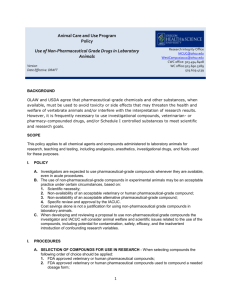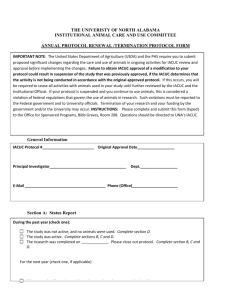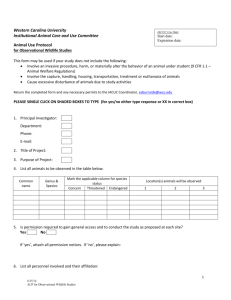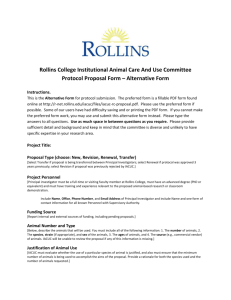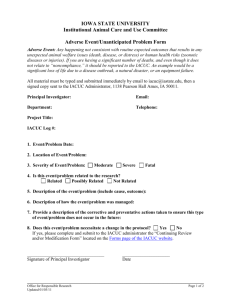Non-Pharmaceutical Grade Compounds
advertisement
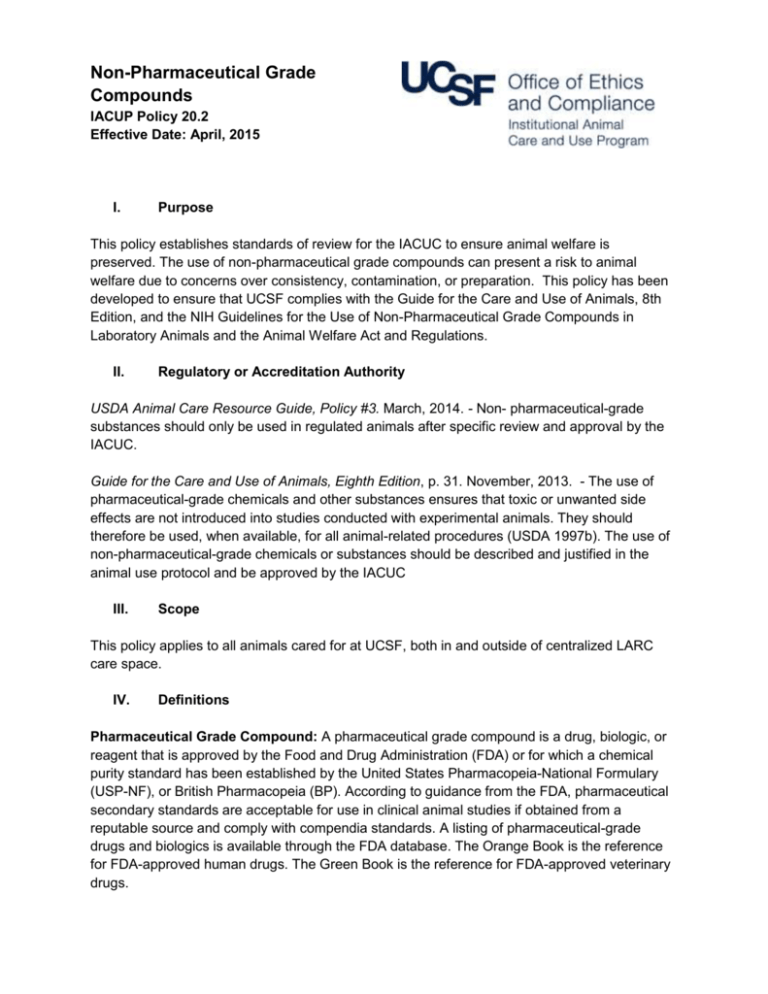
Non-Pharmaceutical Grade Compounds IACUP Policy 20.2 Effective Date: April, 2015 I. Purpose This policy establishes standards of review for the IACUC to ensure animal welfare is preserved. The use of non-pharmaceutical grade compounds can present a risk to animal welfare due to concerns over consistency, contamination, or preparation. This policy has been developed to ensure that UCSF complies with the Guide for the Care and Use of Animals, 8th Edition, and the NIH Guidelines for the Use of Non-Pharmaceutical Grade Compounds in Laboratory Animals and the Animal Welfare Act and Regulations. II. Regulatory or Accreditation Authority USDA Animal Care Resource Guide, Policy #3. March, 2014. - Non- pharmaceutical-grade substances should only be used in regulated animals after specific review and approval by the IACUC. Guide for the Care and Use of Animals, Eighth Edition, p. 31. November, 2013. - The use of pharmaceutical-grade chemicals and other substances ensures that toxic or unwanted side effects are not introduced into studies conducted with experimental animals. They should therefore be used, when available, for all animal-related procedures (USDA 1997b). The use of non-pharmaceutical-grade chemicals or substances should be described and justified in the animal use protocol and be approved by the IACUC III. Scope This policy applies to all animals cared for at UCSF, both in and outside of centralized LARC care space. IV. Definitions Pharmaceutical Grade Compound: A pharmaceutical grade compound is a drug, biologic, or reagent that is approved by the Food and Drug Administration (FDA) or for which a chemical purity standard has been established by the United States Pharmacopeia-National Formulary (USP-NF), or British Pharmacopeia (BP). According to guidance from the FDA, pharmaceutical secondary standards are acceptable for use in clinical animal studies if obtained from a reputable source and comply with compendia standards. A listing of pharmaceutical-grade drugs and biologics is available through the FDA database. The Orange Book is the reference for FDA-approved human drugs. The Green Book is the reference for FDA-approved veterinary drugs. V. Policy Requirements Investigators are expected to use pharmaceutical-grade compounds whenever they are available, even in non-survival procedures. The use of non-pharmaceutical-grade compounds in animal subjects (including experimental compounds) may be acceptable under certain circumstances, based on: Scientific necessity; Non-availability of an acceptable veterinary or human pharmaceutical-grade compound; Non-availability of an acceptable alternative pharmaceutical-grade compound; Specific review and approval by the IACUC; and Appropriate scientific justification. Cost savings alone is not a justification for using non-pharmaceutical grade compounds in laboratory animals. Sterile diluents and non-toxic vehicles must be used in the preparation of all non-pharmaceutical grade compounds. IACUC Appendices for the Use of Non-Pharmaceutical Grade Compounds Appendices are provided as IACUC suggestions or recommendations. Deviation from the attached appendices may require IACUC approval. Appendix A: Guidelines for Selection of Compounds for Use in Research IACUC Approved: April 2015 When selecting compounds the following order of choice should be applied: (This order of preference from the NIH Office of Animal Care and Use (OACU), Animal Research Advisory Committee (ARAC) guideline, “Guidelines for the Use of Non-Pharmaceutical Grade Compounds in Laboratory Animals.”) 1. FDA approved veterinary or human pharmaceutical compounds; The Food and Drug Administration (FDA) maintains a database listing of FDA approved commercial formulations for both FDA approved human drugs (the Orange Book) and veterinary drugs (the Green Book) 2. FDA approved veterinary or human pharmaceutical compounds used to compound a needed dosage form; i.e. FDA approved veterinary or human pharmaceutical compounds that have been diluted or mixed with other FDAapproved compounds in order to be delivered at the appropriate dose and/or volume for a given species. 3. USP/NF or BP pharmaceutical grade compound used in a needed dosage form; A pharmaceutical grade compound recognized by USP will bear the initials “USP” after the name of the compound. 4. Analytical grade bulk chemical used to compound a needed dosage form (requires justification); 5. Other grades and sources of compounds (requires justification). Appendix B: IACUC Considerations for approval of Non-Pharmaceutical-Grade Compounds for Use in Research IACUC Approved: April 2015 When developing and reviewing a proposal to use non-pharmaceutical grade compounds the investigator and IACUC will consider animal welfare and scientific issues related to the use of the compounds, including potential for contamination, safety, efficacy, and the inadvertent introduction of confounding research variables. When the use of non-pharmaceutical-grade substances is proposed, the IACUC should consider the following factors in its decision whether or not to approve the use of the substance: Grade/purity, formulation of the final product, quality control, sterility and factors that may contribute to adverse effects such as, but not limited to, pyrogenicity, stability, pH, osmolality, site/route of administration, pharmacokinetics, and physiological compatibility Appendix C: Guidelines for Commonly Used Compounds IACUC Approved: April 2015 1. Pentobarbital sodium a. Recent exorbitant cost increases of pentobarbital have placed it logistically into the unavailable category. Pentobarbital from a reagent or analytical-grade powder, properly prepared by a pharmacist or other knowledgeable individual (e.g., chemist, veterinarian, researcher), with assurance of appropriate storage and handling, and approval by the IACUC is acceptable. 2. Tribromoethanol (Avertin®) Avertin® is the trade name for the injectable anesthetic 2,2,2-tribromoethanol. Avertin® was once manufactured as a pharmaceutical-grade drug, but it is no longer available. a. The preparation and use of tribromoethanol for survival surgery must be scientifically necessary, appropriately justified and approved by the IACUC. (i) Justification for using tribromoethanol should take into account the availability of commercially available pharmaceutical-grade alternatives, such as ketamine, xylazine, or isoflurane, and include a rationale for why these alternatives cannot be used. (ii) Tribromoethanol is not controlled by the Drug Enforcement Administration (DEA); justification solely based on this fact, however, is not considered scientific or adequate. (iii) Cost or convenience is not a scientific or adequate justification for the use of tribromoethanol. b. If tribromoethanol will be used for anesthesia, it must be properly prepared and stored in accordance with the IACUC Avertin Formulary. c. See the IACUC Guidelines on Preparation and Recipe for Avertin. 3. Tricaine methanesulfonate (TMS, MS-222®, Tricaine®-S, Finquel®) a. Tricaine methanesulfonate is the anesthetic of choice for immersion anesthesia for most fish and amphibian species. It is currently available as a pharmaceutical-grade compound under the trade names Finquel® or Tricaine®-S. Investigators are expected to use pharmaceutical grade TMS, unless scientific justification is provided and approved by the IACUC. b. See the IACUC Guidelines on Preparation and Formulary for Tricaine (MS-222). 4. Urethane, α-chloralose, and chloral hydrate a. Urethane, α-chloralose, and chloral hydrate have been used as injectable anesthetic agents in laboratory animals, particularly rodents. They are not available as pharmaceutical-grade compounds. Although pharmaceutical-grade alternative anesthetics are available, urethane, α-chloralose, and chloral hydrate still have important roles as anesthetic agents in biomedical research due to unique physiologic effects (for example, urethane has minimal respiratory effects). b. Scientific justification should be provided for the use of urethane, α-chloralose, or chloral hydrate instead of commercially available, pharmaceutical grade injectable anesthetics. c. Use of urethane, α-chloralose, and chloral hydrate should be limited to terminal procedures in mammals. d. Urethane is considered a carcinogen and mutagen. Preparation, use, and disposition of this compound should take into account these hazards, and appropriate safety precautions should be reflected in the IACUC protocol, approved by Environmental Health & Radiation Safety, and implemented by laboratory personnel. Appendix D: Guidelines for New Investigational Compounds IACUC Approved: April 2015 New investigational compounds may be produced by a laboratory or supplied by a manufacturer for testing in an experimental setting only. Chemical purity standards are generally not established yet. Therefore, new investigational compounds are considered to be nonpharmaceutical grade with no available human or veterinary pharmaceutical grade equivalent or alternative. Appendix E: Additional References IACUC Approved: April 2015 a. NIH Office of Animal Care and USE, Guidelines for the Use of Non-Pharmaceutical Grade Compounds in Laboratory Animals (Last Revised, 2013) (http://oacu.od.nih.gov/ARAC/documents/Pharmaceutical_Compounds.pdf)(Last Visited, 2013). b. OLAW Position Statement 3) Non-Pharmaceutical-Grade Substances (http://grants.nih.gov/grants/olaw/positionstatement_guide.htm#nonpharma)(Last Visited, 2013) c. United Stats Pharmacopeia-National Formulary(USPNF)(http://www.uspnf.com/uspnf/login) d. British Pharmacopeia(BP)(http://www.pharmacopoeia.co.uk/) e. FDA Drug Approval Database (http://www.fda.gov/Drugs/InformationOnDrugs/default.htm)
